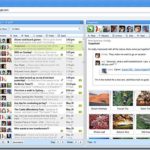
Here I am at a session about Google Wave (presenters: Tim Stack, Utah Education Network, Jared Covili, and Mitchell Jorgensen). I have always been intrigued by this technology, but have not yet found a practical use for it. This session really helped with understanding how Wave works. To try Wave, visit http://wave.google.com.
The whole concept of Google Wave is live, real-time collaboration. A user starts a wave. It can be a simple post, or a more developed idea. Users that you invite to be a part of the wave can edit your post and can see the editing being done live, right in front of you. This session had more than 100 people, so you could see many edits happening all at the same time. In a classroom situation, it would certainly be more manageable. A cool feature about Wave is the ability to “playback” the edits; starting with the original post, then every edit after that point. This makes it easy to follow the progression of the edits. You can also make Waves public, so that anyone may contribute.
In a school setting, I can see the interface being very overwhelming for some students. The teacher would need to present Wave in a very concise method, as to not confuse the students too much. I like the ability to see live edits in front of you. Add in Google chat or Skype, and you are looking at real, live online collaboration. The session, in general, did not go into anything education-related, but was still very useful. I would have loved to see a Part 2, getting into practical applications for the classroom. To get started, I am going search for some public waves and get used to the interface, how it works, and come up with some great ideas for the classroom.
John P. Collins is the technology coordinator/district web site administrator for West Bridgewater Middle-Senior High School in Massachusetts, and is chairperson of the Massachusetts Music Educators Association Southeast District.
- Friday 5: Digital equity in schools - May 24, 2024
- 5 key recommendations for AI in education - May 23, 2024
- Personalized Learning: eSN Innovation Roundtable - May 22, 2024

